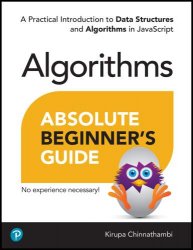Absolute Beginner's Guide to Algorithms: A Practical Introduction to Data Structures and Algorithms in Javascript (Final)
- Добавил: literator
- Дата: 18-08-2024, 19:47
- Комментариев: 0
 Название: Absolute Beginner's Guide to Algorithms: A Practical Introduction to Data Structures and Algorithms in jаvascript (Final)
Название: Absolute Beginner's Guide to Algorithms: A Practical Introduction to Data Structures and Algorithms in jаvascript (Final) Автор: Kirupa Chinnathambi
Издательство: Addison-Wesley Professional/Pearson
Год: 2024
Страниц: 413
Язык: английский
Формат: True/Retail (PDF EPUB)
Размер: 84.9 MB
A hands-on, easy-to-comprehend guide that is perfect for anyone who needs to understand algorithms.
With the explosive growth in the amount of data and the diversity of computing applications, efficient algorithms are needed now more than ever. Programming languages come and go, but the core of programming--algorithms and data structures--remains the same.
Absolute Beginner's Guide to Algorithms is the fastest way to learn algorithms and data structures. Using helpful diagrams and fully annotated code samples in jаvascript, you will start with the basics and gradually go deeper and broader into all the techniques you need to organize your data.
Programming is all about taking data and manipulating it in all sorts of interesting ways. Now, depending on what we are doing, our data needs to be represented in a form that makes it easy for us to actually use. This form is better known as a data structure. As we will see shortly, data structures give the data we are dealing with a heavy dose of organization and scaffolding. This makes manipulating our data easier and (often) more efficient.
Recursion is a powerful programming technique that allows us to break down large, complicated problems into smaller, more manageable pieces. Not only is it a valuable tool in our coding toolkit, but understanding recursion will also help us improve our logical thinking and problem-solving skills. So why wait? In this chapter, we get a good overview on what recursion is and why knowing more about it will kick our coding skills up a bunch of notches!
If there was a Greatest Hits list of popular algorithms, the Fibonacci sequence would be right at the top. It would be the Beatles or the Rolling Stones of its generation. The Fibonacci sequence is a series of numbers in which each number is the sum of the previous two numbers. The sequence starts with 0 and 1, and then each subsequent number is the sum of the previous two. So, the sequence goes 0, 1, 1, 2, 3, 5, 8, 13, 21, 34, and so on.
In our algorithmic digital world, when we talk about search or searching, we are still trying to find something. The key difference is that what we are trying to find will live in a collection of data, such as an array, a list, or a tree. Depending on what we are looking for and what the collection of data looks like, we will employ a variety of approaches to help us find something efficiently. These varieties of approaches have a more formal name: search algorithms. Together, we’re going to look at some really popular search algorithms, each with its own unique twist that makes it special. In this chapter, we start our journey by looking at one of the most approachable search algorithms, the linear search (sometimes called a sequential search).
Start fast with data structures basics: arrays, stacks, queues, trees, heaps, and more
Walk through popular search, sort, and graph algorithms
Understand Big-O notation and why some algorithms are fast and why others are slow
Balance theory with practice by playing with the fully functional jаvascript implementations of all covered data structures and algorithms
Скачать Absolute Beginner's Guide to Algorithms (Final)
Внимание
Уважаемый посетитель, Вы зашли на сайт как незарегистрированный пользователь.
Мы рекомендуем Вам зарегистрироваться либо войти на сайт под своим именем.
Уважаемый посетитель, Вы зашли на сайт как незарегистрированный пользователь.
Мы рекомендуем Вам зарегистрироваться либо войти на сайт под своим именем.
Информация
Посетители, находящиеся в группе Гости, не могут оставлять комментарии к данной публикации.
Посетители, находящиеся в группе Гости, не могут оставлять комментарии к данной публикации.
